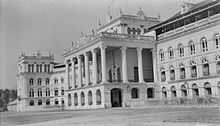Narayanhity Palace
| Narayanhiti Palace | |
|---|---|
|
The Narayanhiti Palace in 2006. |
The Narayanhiti Palace, or Narayanhiti Durbar, is a palace in Kathmandu, Nepal, which long served as a primary residence for the country's monarchs.[1][2][3] This building is among the most visited buildings in Nepal.
Etymology
The name, Narayanhiti, is made up of two words ‘narayan’ and ‘hiti’. Narayan is the name of an incarnation of the Hindu god Vishnu, whose temple is located opposite to the palace. ‘Hiti’ means “water spout” which is also located to the east of main entrance in the precincts of the palace, a landmark that features prominently in local legends.

History
The palace compound is located in the north-central part of Kathmandu, at the head of Durbar marg. It is designed to be a contemporary pagoda with sprawling, park-like grounds covering an area of (38 hectares (94 acres)) all fully enclosed with walls and guarded gates. Its southern walls are considered the tallest in Nepal. The current palace was built in 1970, on the order of King Mahendra (who preferred Nepalese architecture for the palace over the previous European one) replacing the original building designed by a master Nepalese architect Jogbir Sthapit in 1886, which in turn had been built on the site of the palace of Rana prime minister Ranodip Singh Kunwar after it was demolished following his assassination in 1885.
The new palace as it looks today was first used on the occasion of the marriage of Prince Birendra the then-heir apparent to the throne. The southern gate of the palace is located at the intersection of Prithvi path and Durbar marg streets. The palace was also the scene of the 2001 Nepalese Royal Massacre. After the 2006 revolution toppled the monarchy, the newly elected assembly declared Nepal a republic and ordered King Gyanendra to vacate the palace.
The royal palace was turned into a public museum immediately after the country was declared a republic. The crown jewels are considered to be among the most valuable objects in Nepal.
References
- ↑ http://www.tripadvisor.com.au/Attraction_Review-g293890-d3382704-Reviews-Narayanhiti_Palace_Museum-Kathmandu_Kathmandu_Valley_Bagmati_Zone_Central_Region.html
- ↑ http://www.theguardian.com/travel/gallery/2009/may/25/nepal-royal-family-palace-museum
- ↑ http://www.theguardian.com/travel/2009/may/26/nepal-royal-palace-museum
Coordinates: 27°42′56″N 85°19′12″E / 27.71556°N 85.32000°E
